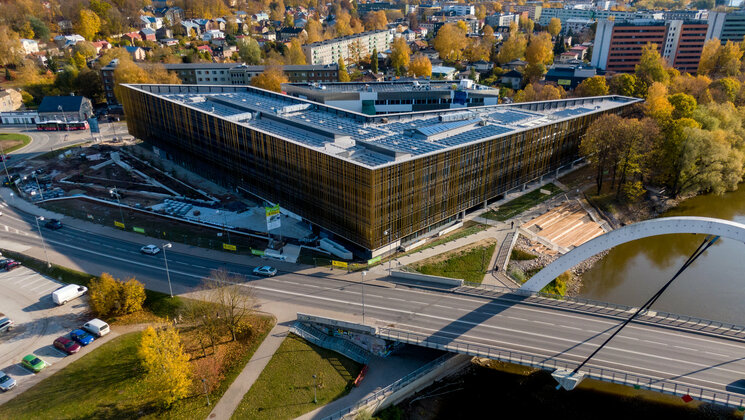-
Faculty of Arts and HumanitiesDean's Office, Faculty of Arts and HumanitiesJakobi 2, r 116-121 51005 Tartu linn, Tartu linn, Tartumaa EST0Institute of History and ArchaeologyJakobi 2 51005 Tartu linn, Tartu linn, Tartumaa EST0Institute of Estonian and General LinguisticsJakobi 2, IV korrus 51005 Tartu linn, Tartu linn, Tartumaa EST0Institute of Philosophy and SemioticsJakobi 2, III korrus, ruumid 302-337 51005 Tartu linn, Tartu linn, Tartumaa EST0Institute of Cultural ResearchÜlikooli 16 51003 Tartu linn, Tartu linn, Tartumaa EST0Institute of Foreign Languages and CulturesLossi 3 51003 Tartu linn, Tartu linn, Tartumaa EST0School of Theology and Religious StudiesÜlikooli 18 50090 Tartu linn, Tartu linn, Tartumaa EST0Viljandi Culture AcademyPosti 1 71004 Viljandi linn, Viljandimaa EST0Professors emeriti, Faculty of Arts and Humanities0Associate Professors emeriti, Faculty of Arts and Humanities0Faculty of Social SciencesDean's Office, Faculty of Social SciencesLossi 36 51003 Tartu linn, Tartu linn, Tartumaa EST0Institute of EducationJakobi 5 51005 Tartu linn, Tartu linn, Tartumaa EST0Johan Skytte Institute of Political StudiesLossi 36, ruum 301 51003 Tartu linn, Tartu linn, Tartumaa EST0School of Economics and Business AdministrationNarva mnt 18 51009 Tartu linn, Tartu linn, Tartumaa EST0Institute of PsychologyNäituse 2 50409 Tartu linn, Tartu linn, Tartumaa EST0School of LawNäituse 20 - 324 50409 Tartu linn, Tartu linn, Tartumaa EST0Institute of Social StudiesLossi 36 51003 Tartu linn, Tartu linn, Tartumaa EST0Narva CollegeRaekoja plats 2 20307 Narva linn, Ida-Virumaa EST0Pärnu CollegeRingi 35 80012 Pärnu linn, Pärnu linn, Pärnumaa EST0Professors emeriti, Faculty of Social Sciences0Associate Professors emeriti, Faculty of Social Sciences0Faculty of MedicineDean's Office, Faculty of MedicineRavila 19 50411 Tartu linn, Tartu linn, Tartumaa ESTInstitute of Biomedicine and Translational MedicineBiomeedikum, Ravila 19 50411 Tartu linn, Tartu linn, Tartumaa ESTInstitute of PharmacyNooruse 1 50411 Tartu linn, Tartu linn, Tartumaa ESTInstitute of DentistryL. Puusepa 1a 50406 Tartu linn, Tartu linn, Tartumaa ESTInstitute of Clinical MedicineL. Puusepa 8 50406 Tartu linn, Tartu linn, Tartumaa ESTInstitute of Family Medicine and Public HealthRavila 19 50411 Tartu linn, Tartu linn, Tartumaa ESTInstitute of Sport Sciences and PhysiotherapyUjula 4 51008 Tartu linn, Tartu linn, Tartumaa ESTProfessors emeriti, Faculty of Medicine0Associate Professors emeriti, Faculty of Medicine0Faculty of Science and TechnologyDean's Office, Faculty of Science and TechnologyVanemuise 46 - 208 51003 Tartu linn, Tartu linn, Tartumaa ESTInstitute of Computer ScienceNarva mnt 18 51009 Tartu linn, Tartu linn, Tartumaa ESTInstitute of GenomicsRiia 23b/2 51010 Tartu linn, Tartu linn, Tartumaa ESTEstonian Marine Institute0Institute of PhysicsInstitute of ChemistryRavila 14a 50411 Tartu linn, Tartu linn, Tartumaa EST0Institute of Mathematics and StatisticsNarva mnt 18 51009 Tartu linn, Tartu linn, Tartumaa EST0Institute of Molecular and Cell BiologyRiia 23, 23b - 134 51010 Tartu linn, Tartu linn, Tartumaa ESTTartu ObservatoryObservatooriumi 1 61602 Tõravere alevik, Nõo vald, Tartumaa EST0Institute of TechnologyNooruse 1 50411 Tartu linn, Tartu linn, Tartumaa ESTInstitute of Ecology and Earth SciencesJ. Liivi tn 2 50409 Tartu linn, Tartu linn, Tartumaa ESTProfessors emeriti, Faculty of Science and Technology0Associate Professors emeriti, Faculty of Science and Technology0Institute of BioengineeringArea of Academic SecretaryHuman Resources OfficeUppsala 6, Lossi 36 51003 Tartu linn, Tartu linn, Tartumaa EST0Area of Head of FinanceFinance Office0Area of Director of AdministrationInformation Technology Office0Administrative OfficeÜlikooli 17 (III korrus) 51005 Tartu linn, Tartu linn, Tartumaa EST0Estates Office0Marketing and Communication OfficeÜlikooli 18, ruumid 102, 104, 209, 210 50090 Tartu linn, Tartu linn, Tartumaa EST0Area of RectorRector's Strategy OfficeInternal Audit OfficeArea of Vice Rector for Academic AffairsOffice of Academic AffairsUniversity of Tartu Youth AcademyUppsala 10 51003 Tartu linn, Tartu linn, Tartumaa EST0Student Union OfficeÜlikooli 18b 51005 Tartu linn, Tartu linn, Tartumaa EST0Centre for Learning and TeachingArea of Vice Rector for ResearchUniversity of Tartu LibraryW. Struve 1 50091 Tartu linn, Tartu linn, Tartumaa EST0Grant OfficeArea of Vice Rector for DevelopmentCentre for Entrepreneurship and InnovationNarva mnt 18 51009 Tartu linn, Tartu linn, Tartumaa EST0University of Tartu Natural History Museum and Botanical GardenVanemuise 46 51003 Tartu linn, Tartu linn, Tartumaa EST0International Cooperation and Protocol Office0University of Tartu MuseumLossi 25 51003 Tartu linn, Tartu linn, Tartumaa EST0
Researchers have discovered new genetic risk factors in polycystic ovary syndrome

A recent article published by researchers at the Institute of Genomics of the University of Tartu in the journal Human Reproduction described new links between polycystic ovary syndrome and genetics.
Polycystic ovary syndrome is the most common endocrine disorder in women, characterised by irregular periods, high levels of androgen hormones and/or enlarged ovaries with many follicles containing the eggs (known as polycystic ovaries), which might affect fertility and the risk for other metabolic disorders. “It is a multifactorial condition, meaning both genetics and environmental or lifestyle factors increase the risk,” said Triin Laisk, Associate Professor at the Institute of Genomics.
To search for these variants in polycystic ovary syndrome, genome-wide association studies can be conducted. “This technique compares the genetic material (DNA) sequence in women with polycystic ovary syndrome, for instance, to women without the condition and allows the identification of sequence changes which are more frequent in the group with the trait of interest,” said Laisk.
Using a similar approach, a previous study including a large number of women from diverse European populations, identified genes involved in DNA repair, maturation of the ovarian follicles that contain the oocytes, cell growth and division, and synthesis of androgen hormones, amongst others, to be linked to polycystic ovary syndrome.
In this study, using the same approach but only including Estonian and Finnish populations, two new rare genetic variants that increase the risk for polycystic ovary syndrome are described, which likely affect the gene CHEK2. “Due to differences in demographic history, the enrichment of some variants in Finnish and Estonian populations provided a unique opportunity to capture novel rare genetic variants associated with polycystic ovary syndrome when focusing only on these populations”, explained PhD student Natàlia Pujol Gualdo, who is co-first author of this work.
CHEK2 encodes for a protein which is an important factor in the quality control of cells and the repair of damage in the DNA. CHEK2 has been also linked to ovarian reserve and variation in age at menopause, which goes in line with the observed later age at menopause in women with polycystic ovary syndrome. “Further research is needed to explore the role of CHEK2 variation in polycystic ovary syndrome and we hope this study serves as a base for further experiments that can clarify their interplay. At the same time, this study highlights the importance of population-specific biobank initiatives as unique means to seek into the genetic landscape of complex diseases,” said Laisk.
The study, co-led by colleagues from the University of Oulu, forms a basis for collaboration to study the genetic underpinnings of diverse female reproductive conditions leveraging unique data from Estonian and Finnish populations. Thanks to all biobank participants in the project, the authors were able to analyse genetic data of over 233 000 women from the Estonian Biobank and the FinnGen study coordinated by the University of Helsinki – which enabled the identification of novel genetic risk factors in polycystic ovary syndrome.
Further information: Karoliina Kruusmaa, Communications Specialist, Institute of Genomics, University of Tartu, karoliina.kruusmaa@ut.ee
Read more similar news






